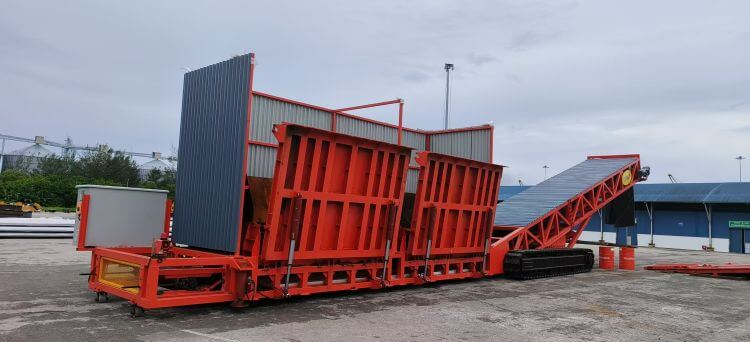When bulk material handling operations are suddenly interrupted due to hydraulic system failure or Conveyor Belt breakage, every minute of downtime erodes operational profits. As critical equipment in mines, ports, and power plants, truck unloaders must withstand the impact of hundred-ton loads while operating at high frequencies in harsh environments with dust, vibration, and temperature fluctuations. Equipment lacking scientific maintenance is like a sports car without oil changes - performance declines, failures multiply, and service life plummets.

I. Hydraulic System: Key Maintenance Points
The hydraulic system controls equipment lifting, ramp adjustment and travel functions, requiring focused attention:
Hydraulic Oil Management
Oil management is the foundation of system stability. Strictly implement oil specifications: Use designated anti-wear hydraulic oil (e.g. ISO VG 46/68), never mix brands to prevent additive failure; establish scientific replacement intervals (first change at 500 operating hours, then mandatory changes every 2000 hours or annually), with simultaneous filter replacement; implement a three-level monitoring system: daily dipstick checks for safe oil levels, quarterly lab tests for oil viscosity, water content and contaminants, with the core being maintaining 40-60°C operating temperature (clean cooler immediately if exceeding 80°C), forming a complete oil maintenance cycle.
Pipeline and Filter Maintenance
Implement graded protection for piping systems: daily inspections for hose bulging/leaks and pipe corrosion, mandatory replacement of hydraulic hoses after 6 years of service; periodic filter replacement based on actual conditions (every 500-1000 hours), emphasizing use of Zoomry OEM parts to ensure filtration accuracy; through triple protection of daily checks + mandatory replacement + genuine parts, effectively prevent pipe bursts and system contamination.
Key Accessory Maintenance
Adopt preventive procedures for ancillary components: monthly cleaning of tank breathers to ensure ventilation, dust-proof sealing before hydraulic component disassembly, while using torque wrenches for monthly tightening of hydraulic connections (focusing on pump/valve interfaces and cylinder joints), maintaining system airtightness, cleanliness and connection reliability through integrated maintenance actions.
II. Mechanical Structure Maintenance
Frame and Load-bearing Components
Standardize maintenance procedures for truck unloader frames: weekly torque wrench tightening of bolts at critical junctions like frame connections and roller bearing housings; monthly inspection of weld conditions on load-bearing structures like hopper supports, with immediate crack repair when found; simultaneously monitor wear plate thickness in hoppers - mandatory replacement when remaining thickness is below 30% (over 70% worn), ensuring overall structural stability.
Conveyor System Maintenance
Conveyor belt maintenance includes three operations: daily cleaning of material buildup on rollers, timely correction of belt misalignment through training idlers, and cold repair of surface cuts. The roller system requires daily inspection to remove seized rollers (mandatory replacement of failed units within 24 hours), monthly inspection of drive roller lagging wear, while continuously removing adhered material to prevent abnormal belt wear, forming a full-chain protection mechanism for the conveying system.
Undercarriage Maintenance
Implement graded maintenance by equipment type: wheeled units perform daily tire pressure checks and annual hub grease replacement; tracked truck unloaders adjust track sag daily to 10-30mm standard value, with regular lubrication of carrier rollers. Universal maintenance includes monthly inspection of steering pivot wear and clearing grizzly blockages based on material characteristics (with customizable gap adjustment), ensuring mobility reliability across equipment types.
III. Electrical System Maintenance
Control Cabinet Protection
Implement three-phase electrical protection: monthly deep cleaning with vacuum after power-off (prohibiting compressed air), regular checks of door seal airtightness, quarterly systematic tightening of key terminals like PLC and VFD, effectively maintaining IP66 protection rating performance.
Safety Device Testing
Periodic function verification: monthly manual testing of misalignment switch sensitivity, calibration of lift/travel limit switch positions; daily monitoring of remote control battery status (recommended quarterly replacement), building safety barriers for equipment operation.
Cable Protection
Adopt dynamic monitoring strategy: daily visual inspection for power cable jacket damage (focusing on track-type unit chain zones); annual professional maintenance of slip ring brush wear and contact surface cleanliness; while standardizing cable routing to avoid excessive bending, extending cable service life.
IV. Establishing Preventive Maintenance System
Maintenance Schedule Development
Implement graded preventive maintenance: daily checks cover oil level inspection, tire pressure calibration and belt tracking adjustment; weekly focus on bolt torque tightening and visual weld inspection; monthly implementation of filter replacement and control cabinet cleaning; quarterly fluid lab analysis and comprehensive roller evaluation, forming periodic maintenance cycles.
| Frequency | Mandatory Tasks |
|---|---|
| Daily | Oil level/tire pressure check, belt tracking correction |
| Weekly | Bolt tightening, visual weld inspection |
| Monthly | Filter replacement, control cabinet cleaning |
| Quarterly | Fluid lab analysis, comprehensive roller inspection |
Spare Parts Management Principles
Follow three core principles for spare parts system: maintain stock of critical parts like hydraulic filters, roller assemblies and seal kits; prioritize Zoomry OEM parts to ensure dimensional accuracy and material compatibility; establish digital replacement records to track service life, achieving refined spare parts management.
Emergency Response Plan
Targeted solutions for sudden failures: when hydraulic system lacks power, sequentially check oil level/filter blockage/pump-valve leakage; for belt misalignment, prioritize idler angle adjustment and material distribution balancing; for abnormal vibration, use stethoscope to locate source (drive unit or bearing housing) then perform structural reinforcement, quickly restoring equipment operation.
V. Zoomry Professional Maintenance Support
Zoomry provides full lifecycle technical support for truck unloaders: through annual deep inspection services using professional equipment like thermal imagers and oil analyzers to systematically identify potential issues like hydraulic line hotspots, electrical connection temperature rise and structural stress concentrations; implement factory-grade overhauls for core components like hydraulic pumps and gearboxes, using precision measurement equipment to calibrate clearances and replace enhanced sealing components, restoring equipment to factory performance standards; while providing customized onsite training by certified engineers covering operational standards, maintenance techniques and failure prediction methods, forming an integrated "inspection-repair-empowerment" technical support system that significantly reduces overall operational costs.

 ZOOMRY
ZOOMRY

